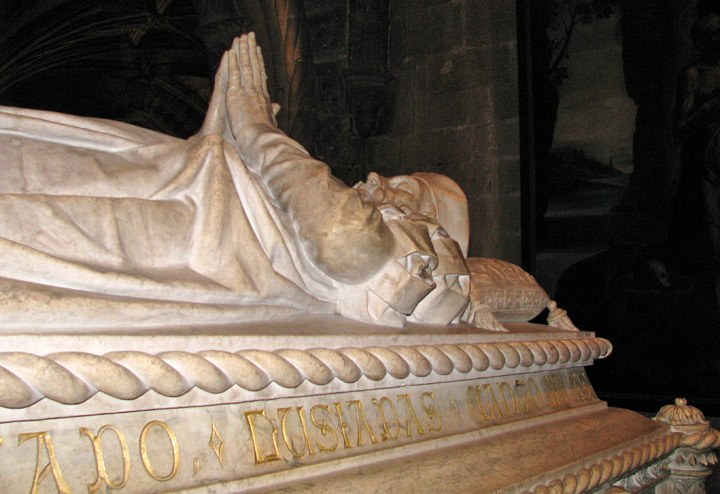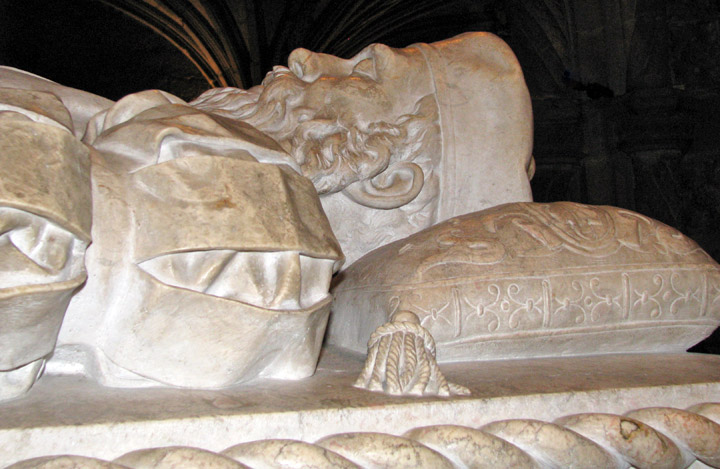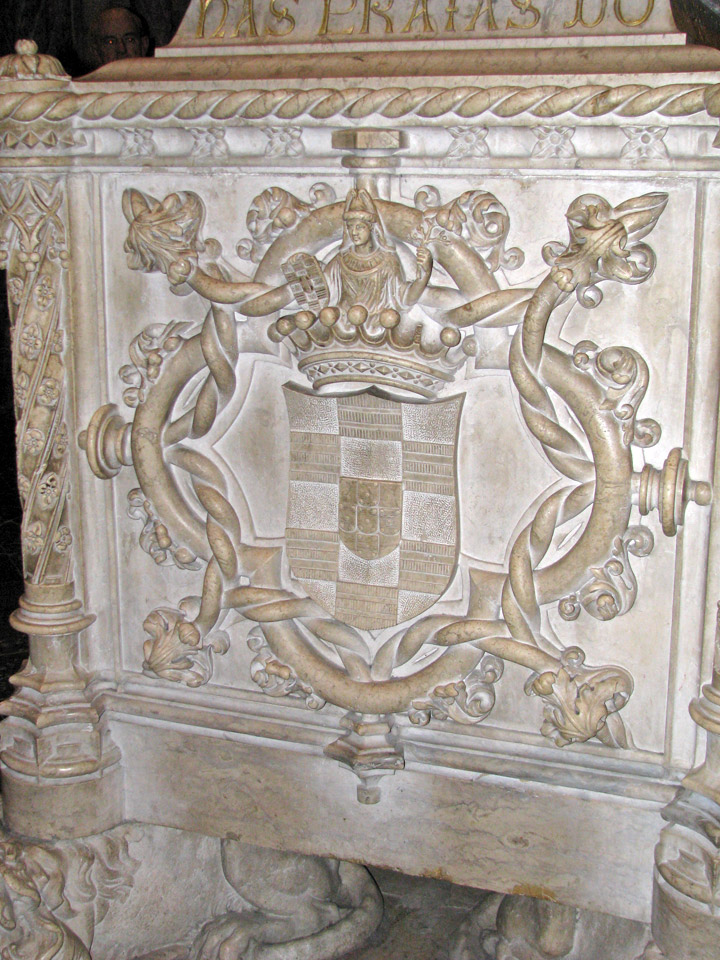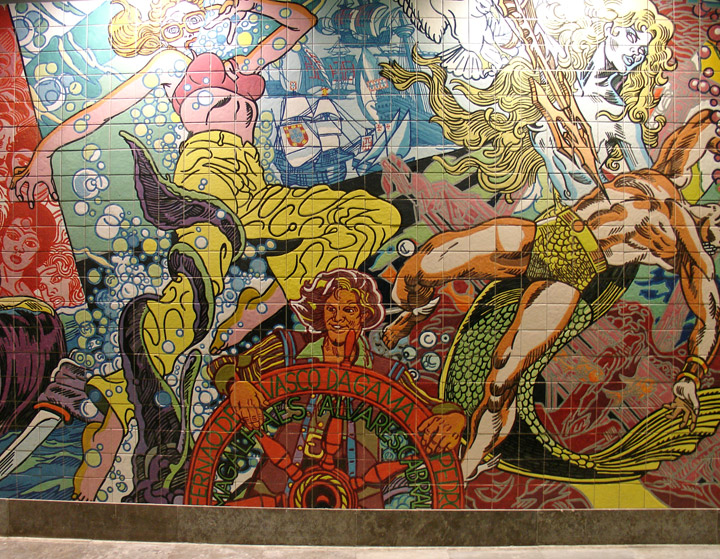

Vasco da Gama
Dom Vasco da Gama, 1st Count of
Vidigueira (Sines or Vidigueira, Alentejo, Portugal, ca. either 1460 or
1469 – December 24, 1524 in Kochi, India) was a Portuguese explorer, one of the
most successful in the European Age of Discovery and the commander of the first
ships to sail directly from Europe to India.
Vasco da Gama was probably born in either 1460 or 1469, in Sines, on the
southwest coast of Portugal, probably in a house near the church of Nossa
Senhora das Salas. Sines, one of the few seaports on the Alentejo coast,
consisted of little more than a cluster of whitewashed, red-tiled cottages,
tenanted chiefly by fisherfolk.
Vasco da Gama's father was Estêvão da Gama. In the 1460s he was a knight in the
household of the Duke of Viseu, Dom Fernando. Dom Fernando appointed him
Alcaide-Mór or Civil Governor of Sines and enabled him to receive a small
revenue from taxes on soap making in Estremoz.
Estêvão da Gama was married to Dona Isabel Sodré, who was the daughter of João
Sodré (also known as João de Resende). Sodré, who was of English descent,[4] had
links to the household of Prince Diogo, Duke of Viseu, son of King Edward I of
Portugal and governor of the military Order of Christ.
Little is known of Vasco da Gama's early life. It has been suggested by the
Portuguese historian Teixeira de Aragão that he studied at the inland town of
Évora, which is where he may have learned mathematics and navigation. It is
evident that Gama knew astronomy well, and it is possible that he may have
studied under the astronomer Abraham Zacuto.

Neomanueline tomb of navigator Vasco da Gama.
In 1492 King John II of Portugal sent
Gama to the port of Setúbal, south of Lisbon and to the Algarve, Portugal's
southernmost province, to seize French ships in retaliation for peacetime
depredations against Portuguese shipping - a task that Vasco rapidly and
effectively performed.
Bartolomeu Dias had already rounded Africa's Cape of Good Hope in 1488, an event
that was the culmination of a several generations of Portuguese sea exploration
initially sponsored by Prince Henry the Navigator.
Gama's voyage was successful in reaching India. This permitted the Portuguese to
trade with the Far East directly by sea, thus challenging older trading networks
of mixed land and sea routes, such as the Spice trade routes that utilized the
Persian Gulf and Red Sea and caravans to reach the eastern Mediterranean. The
Republic of Venice had gained control over much of the trade routes between
Europe and Asia. Portugal hoped to use the route pioneered by Gama to break the
Venetian trading monopoly.
However, Gama's achievements were somewhat dimmed by his failure to bring any
trade goods of interest to the nations of India. Moreover, the sea route was
fraught with its own perils - his fleet went more than three months without
seeing land and only 54 of his 170 companions, on two of his four ships,
returned to Portugal in 1499. Nevertheless, Gama's initial journey opened direct
sea route to Asia that in time helped bring about an era of European domination
through sea power and commerce that lasted several hundred years, as well as 450
years of Portuguese colonialism in India, Asia, and Africa.
From the early fifteenth century, the nautical school of Henry the Navigator had
been extending Portuguese knowledge of the African coastline. From the 1460s,
the goal had become one of rounding that continent's southern extremity to gain
easier access to the riches of India (mainly black pepper and other spices)
through a reliable sea route.

By the time Gama was ten years old, these long-term plans were coming to
fruition. Bartolomeu Dias had returned from rounding the Cape of Good Hope,
having explored as far as the Fish River (Rio do Infante) in modern-day South
Africa and having verified that the unknown coast stretched away to the
northeast.
Concurrent land exploration during the reign of João II of Portugal supported
the theory that India was reachable by sea from the Atlantic Ocean. Pero da
Covilhã and Afonso de Paiva were sent via Barcelona, Naples and Rhodes, into
Alexandria and thence to Aden, Hormuz and India, which gave credence to the
theory.
It remained for an explorer to prove the link between the findings of Dias and
those of da Covilhã and de Paiva and to connect these separate segments into a
potentially lucrative trade route into the Indian Ocean. The task, originally
given to Vasco da Gama's father, was offered to Vasco by Manuel I on the
strength of his record of protecting Portuguese trading stations along the
African Gold Coast from depredations by the French.
On 8 July 1497 the fleet, consisting of four ships and a crew of 170 men, left
Lisbon. The vessels were:
* The São Gabriel, commanded by Vasco da Gama; a carrack of 178 tons, length 27
m , width 8.5 m, draft 2.3 m, sails of 372 m²;
* The São Rafael, whose commander was his brother Paulo da Gama; similar
dimensions to the São Gabriel;
* The caravel Berrio, slightly smaller than the former two (later re-baptized
São Miguel), commanded by Nicolau Coelho;
* A storage ship of unknown name, commanded by Gonçalo Nunes, later lost near
the Bay of São Brás, along the east coast of Africa.

The expedition set sail from Lisbon on July 8, 1497, following the route
pioneered by earlier explorers along the coast of Africa via Tenerife and the
Cape Verde Islands. After reaching the coast of present day Sierra Leone, Gama
took a course south into the open ocean, crossing the Equator and seeking the
South Atlantic westerlies that Bartolomeu Dias had discovered in 1487. This
course proved successful and on November 4, 1497, the expedition made landfall
on the African coast. For over three months the ships had sailed more than 6,000
miles of open ocean, by far the longest journey out of sight of land made by the
time.
By December 16, the fleet had passed the Great Fish River - where Dias had
turned back - and sailed into waters previously unknown to Europeans. With
Christmas pending, Gama and his crew gave the coast they were passing the name
Natal, which carried the connotation of "birth of Christ" in Portuguese.
Arab-controlled territory on the East African coast was an integral part of the
network of trade in the Indian Ocean. Fearing the local population would be
hostile to Christians, Gama impersonated a Muslim and gained audience with the
Sultan of Mozambique. With the paltry trade goods he had to offer, Gama was
unable to provide a suitable gift to the ruler and soon the local populace
became suspicious of Gama and his men. Forced by a hostile crowd to flee
Mozambique, Gama departed the harbor, firing his cannons into the city in
retaliation.
In the vicinity of modern Kenya, the expedition resorted to piracy, looting Arab
merchant ships - generally unarmed trading vessels without heavy cannon. The
Portuguese became the first known Europeans to visit the port of Mombasa but
were met with hostility and soon departed.

detail of the tomb
In February 1498, Vasco da Gama
continued north, landing at the friendlier port of Malindi - whose leaders were
then in conflict with those of Mombasa - and there the expedition first noted
evidence of Indian traders. Gama and his crew contracted the services of a pilot
whose knowledge of the monsoon winds allowed him to bring the expedition the
rest of the way to Calicut (modern Kozhikode), located on the southwest coast of
India. Sources differ over the identity of the pilot, calling him variously a
Christian, a Muslin, and a Gujarati. One traditional story describes the pilot
as the famous Arab navigator Ibn Majid, but other contemporaneous accounts place
Majid elsewhere, and he could not been near the vicinity at the time.
The fleet arrived in Calicut on 20 May 1498. Negotiations with the local ruler,
the Zamorin of Calicut, occasionally took on a violent nature. Efforts by Gama
and the Portuguese to obtain favorable trade terms were complicated by
resistance from indigenous Arab merchants. Eventually Gama was able to gain an
ambiguous letter of concession for trading rights, but he had to depart without
giving notice of his intention to do so after the Zamorin insisted that Gama
leave all his goods as collateral. Vasco da Gama kept his goods, but left a few
Portuguese with orders to start a trading post.
Vasco da Gama set sail for home on August 29, 1498. Eager to leave he ignored
the local knowledge of monsoon wind patterns, which was still blowing onshore.
Crossing the Indian Ocean to India, sailing with the monsoon wind, had taken
Gama's ships only 23 days. The return trip across the ocean, sailing against the
wind, took 132 days, and Gama arrived in Malindi on January 7, 1499. During this
trip, approximately half of the crew died, and many of the rest were afflicted
with scurvy. Two of Gama's ships made it back to Portugal, arriving in July and
August of 1499.
Paulo da Gama died in the Azores on the homeward voyage. Vasco da Gama returned
to Portugal in September 1499 and was richly rewarded as the man who had brought
to fruition a plan that had taken eighty years to fulfill. He was given the
title "Admiral of the Indian Seas," and his feudal rights to Sines were
confirmed. Manuel I also awarded the perpetual title of Dom (lord) to Gama, as
well as to his brothers and sisters and to all of their descendants. He was
created first Earl of Vidigueira, and Gama was named the first Portuguese count
who was not born with royal blood.

detail of tomb
The spice trade would prove to be a
major asset to the Portuguese economy, and other consequences soon followed. For
example, Gama's voyage had made it clear that the east coast of Africa, the
Contra Costa, was essential to Portuguese interests; its ports provided fresh
water, provisions, timber, and harbors for repairs, and served as a refuge where
ships could wait out unfavorable weather. One significant result was the
colonization of Mozambique by the Portuguese Crown.
On 12 February 1502, Gama sailed with a fleet of twenty warships, with the
object of enforcing Portuguese interests in the east. This was subsequent to the
voyage of Pedro Álvares Cabral, who had been sent to India two years earlier.
(Swinging far to the west across the Atlantic in order to make use of the
pattern of favourable winds, Cabral became the official European discoverer of
Brazil. The find may have been an accident). When he finally reached India,
Cabral learned that the Portuguese citizens who had been left by Gama at the
trading post had been murdered. After encountering further resistance from the
locals, he bombarded Calicut and then sailed south of Calicut to reach Cochin, a
small kingdom where he was given a warm welcome. He returned to Europe with silk
and gold.
Once he had reached the northern parts of the Indian Ocean, Gama waited for a
ship to return from Mecca and seized all the merchandise on it. He then ordered
that the hundreds of passengers be locked in the hold and the ship - which was
named Mîrî, and which contained many wealthy Muslim merchants - to be set on
fire. When Gama arrived at Calicut on October 30, 1502 the Zamorin was
willing to sign a treaty.
Gama assaulted and exacted tribute from the Arab-controlled port of Kilwa in
East Africa, one of those ports involved in frustrating the Portuguese. His
ships engaged in privateer actions against Arab merchant ships, and then
destroyed a Calicut fleet of twenty-nine ships. Following that battle he
extracted favorable trading concessions from the Zamorin.
On his return to Portugal, in September 1503, he was made Count of Vidigueira,
with his seat in land sold to him by the Duke of Bragança (the future royal
family of Bragança). He was also awarded feudal rights and jurisdiction over
Vidigueira and Vila dos Frades.

memorial at Oriente station
Having acquired a fearsome reputation
as a "fixer" of problems that arose in India, Vasco da Gama was sent to the
subcontinent once more in 1524.
The intention was that he was to replace the incompetent Eduardo de Menezes as
viceroy (representative) of the Portuguese possessions, but Gama contracted
malaria not long after arriving in Goa and died in the city of Cochin on
Christmas Eve in 1524.
His body was first buried at St. Francis Church, which was located at Fort Kochi
in the city of Kochi, but his remains were returned to Portugal in 1539. The
body of Vasco da Gama was re-interred in Vidigueira in a casket decorated with
gold and jewels.
The Monastery of the Hieronymites in Belém was erected in honor of his voyage to
India.
Gama and his wife, Catarina de Ataíde, had six sons and one daughter: Dom
Francisco da Gama, 2nd Count of Vidigueira; Dom Estevão da Gama, 11th Governor
of India (1540-1542); Dom Paulo da Gama; Dom Pedro da Silva da Gama; Dom Álvaro
de Ataíde da Gama, Captain of Malacca; Dona Isabel de Ataíde da Gama and Dom
Cristovão da Gama, a Martyr in Ethiopia. His male line issue became extinct in
1747, though the title went through female line.
As much as anyone after Henry the Navigator, Gama was responsible for Portugal's
success as an early colonising power. Beside the fact of the first voyage
itself, it was his astute mix of politics and war on the other side of the world
that placed Portugal in a prominent position in Indian Ocean trade. Following
Gama's initial voyage, the Portuguese crown realized that securing outposts on
the eastern coast of Africa would prove vital to maintaining national trade
routes to the Far East.
The Portuguese national epic, the Lusíadas of Luís Vaz de Camões, largely
concerns Vasco da Gama's voyages. The 1865 opera L'Africaine: Opéra en Cinq
Actes, composed by Giacomo Meyerbeer and Eugène Scribe, prominently includes the
character of Vasco da Gama. A 1989 production of the composition by the San
Francisco Opera featured noted Italian tenor Placido Domingo in the role of Gama.
The port city of Vasco da Gama in Goa is named after him, as is the Vasco da
Gama crater, a big crater on the Moon. There are three football clubs in Brazil
(including Club de Regatas Vasco da Gama) and Vasco Sports Club in Goa that were
also named after him. A church in Kochi, Kerala Vasco da Gama Church, a private
residence on the island of Saint Helena and Lisbon's Vasco da Gama Bridge and
Centro Vasco da Gama shopping centre are also named after him. The suburb of
Vasco in Cape Town also honors him.
Text from Wikipedia
Return to Jerónimos Monastery page